TOYOTA 86 2022 Owner's Manual
Manufacturer: TOYOTA, Model Year: 2022, Model line: 86, Model: TOYOTA 86 2022Pages: 449, PDF Size: 8.5 MB
Page 21 of 449
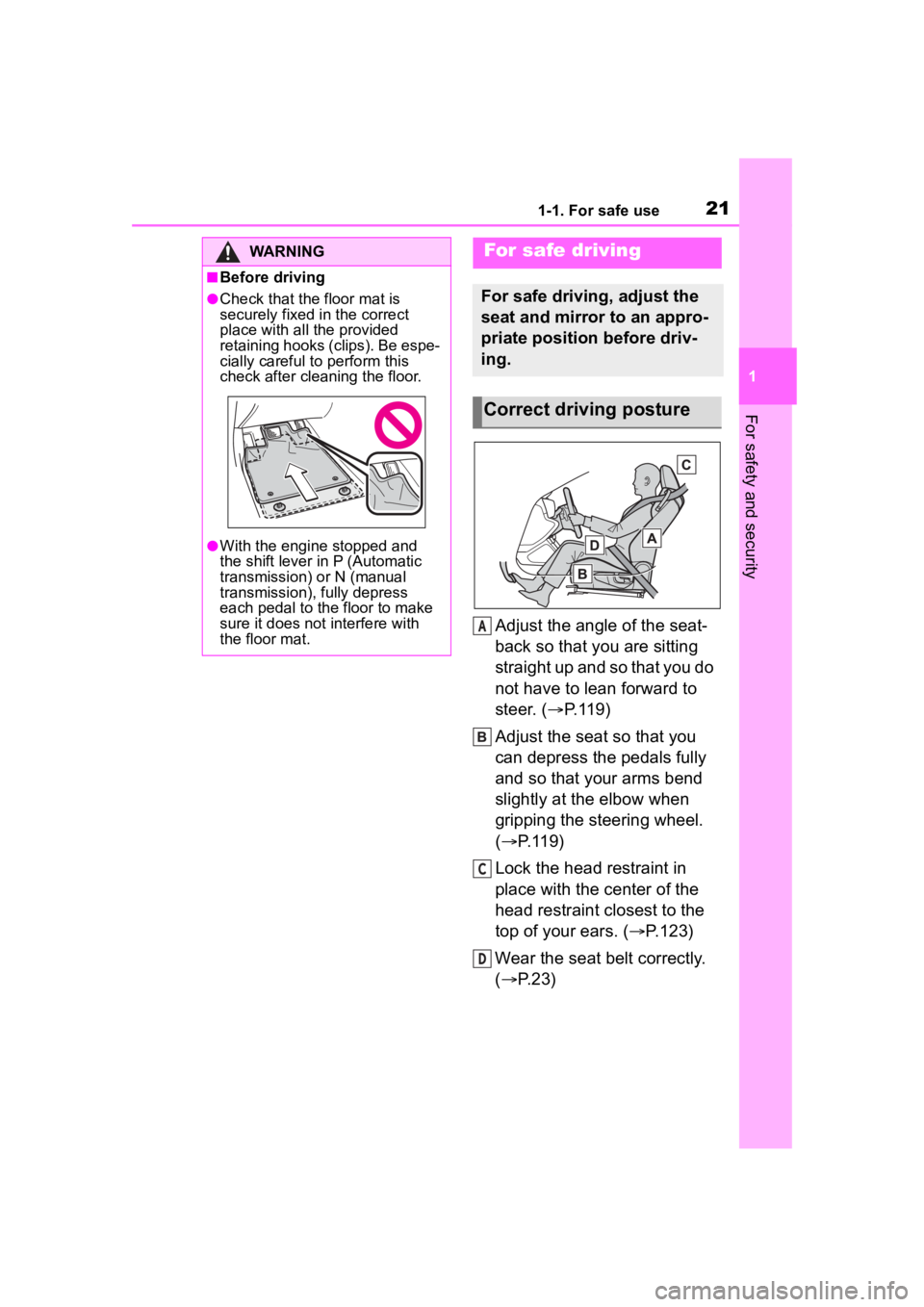
211-1. For safe use
1
For safety and security
Adjust the angle of the seat-
back so that you are sitting
straight up and so that you do
not have to lean forward to
steer. (P.119)
Adjust the seat so that you
can depress the pedals fully
and so that your arms bend
slightly at the elbow when
gripping the steering wheel.
( P.119)
Lock the head restraint in
place with the center of the
head restraint closest to the
top of your ears. ( P.123)
Wear the seat belt correctly.
( P.23)
WARNING
■Before driving
●Check that the floor mat is
securely fixed in the correct
place with all the provided
retaining hooks (clips). Be espe-
cially careful to perform this
check after cleaning the floor.
●With the engine stopped and
the shift lever in P (Automatic
transmission) or N (manual
transmission), fully depress
each pedal to the floor to make
sure it does not interfere with
the floor mat.
For safe driving
For safe driving, adjust the
seat and mirror to an appro-
priate position before driv-
ing.
Correct driving posture
A
C
D
Page 22 of 449
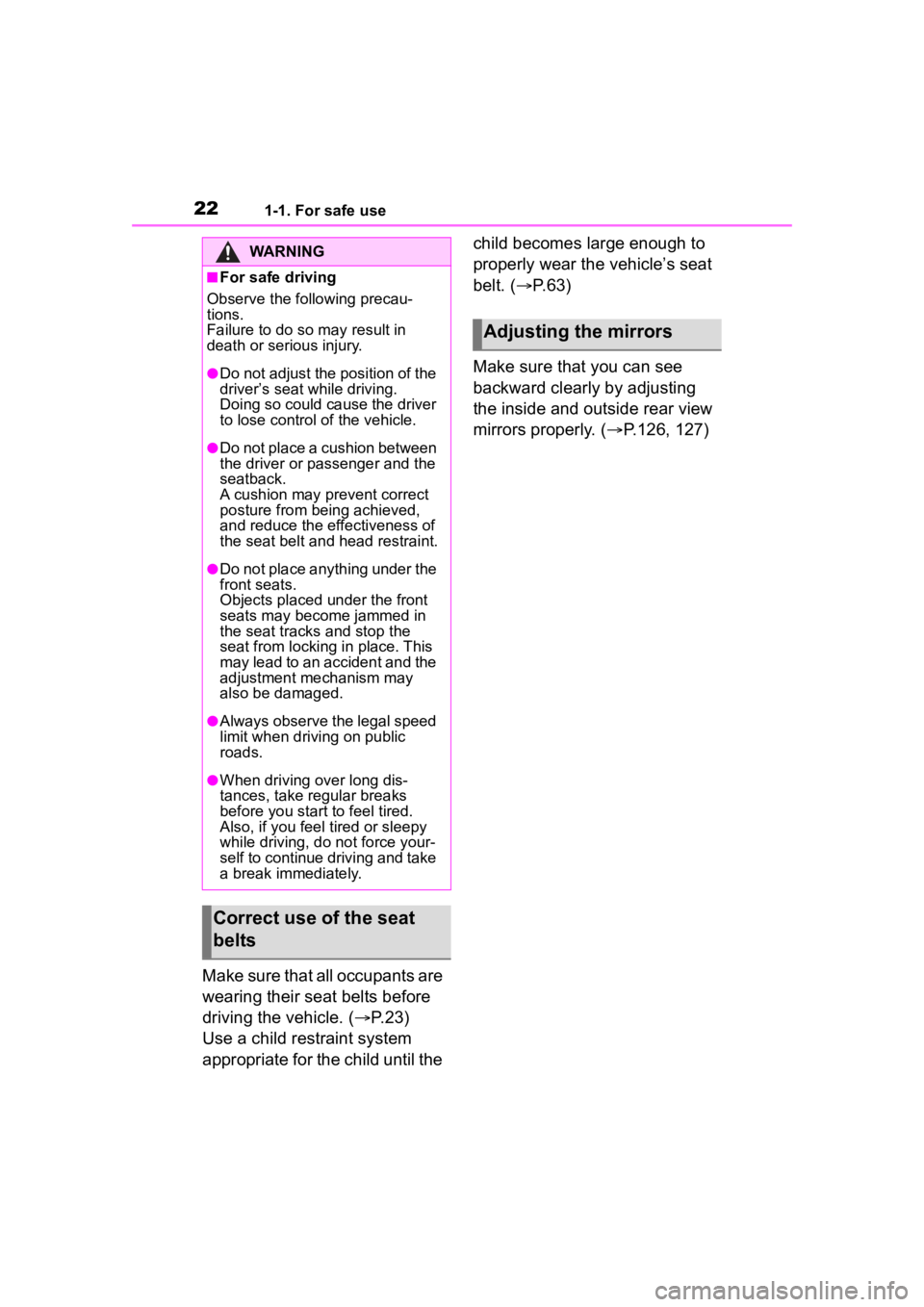
221-1. For safe use
Make sure that all occupants are
wearing their seat belts before
driving the vehicle. (P.23)
Use a child restraint system
appropriate for the child until the child becomes large enough to
properly wear the vehicle’s seat
belt. (
P.63)
Make sure that you can see
backward clearly by adjusting
the inside and outside rear view
mirrors properly. ( P.126, 127)
WARNING
■For safe driving
Observe the following precau-
tions.
Failure to do so m ay result in
death or serious injury.
●Do not adjust the position of the
driver’s seat while driving.
Doing so could cause the driver
to lose control of the vehicle.
●Do not place a cushion between
the driver or passenger and the
seatback.
A cushion may prevent correct
posture from being achieved,
and reduce the effectiveness of
the seat belt and head restraint.
●Do not place anything under the
front seats.
Objects placed under the front
seats may become jammed in
the seat tracks and stop the
seat from locking in place. This
may lead to an accident and the
adjustment mechanism may
also be damaged.
●Always observe the legal speed
limit when driving on public
roads.
●When driving over long dis-
tances, take regular breaks
before you start to feel tired.
Also, if you feel tired or sleepy
while driving, do not force your-
self to continue driving and take
a break immediately.
Correct use of the seat
belts
Adjusting the mirrors
Page 23 of 449
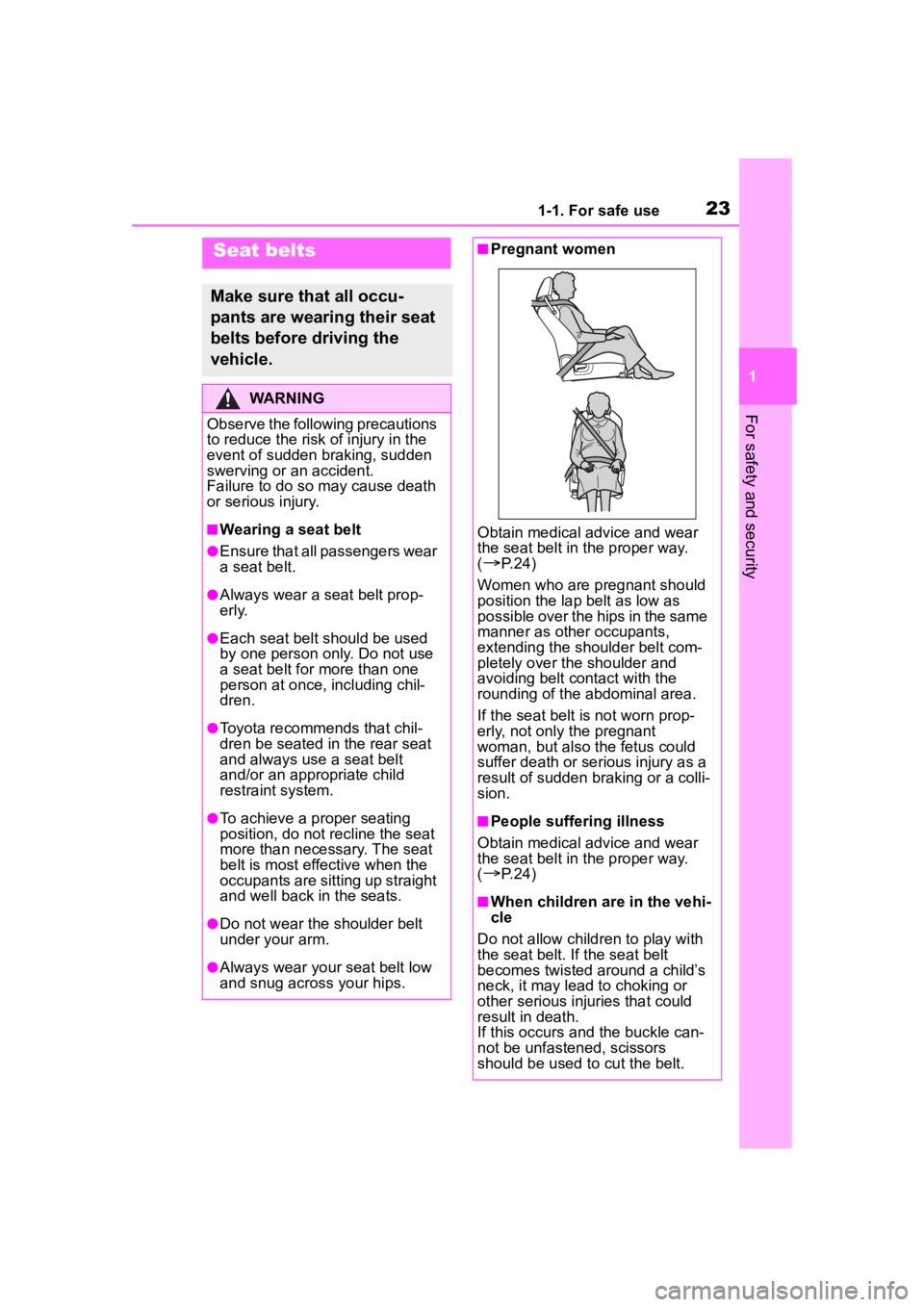
231-1. For safe use
1
For safety and security
Seat belts
Make sure that all occu-
pants are wearing their seat
belts before driving the
vehicle.
WARNING
Observe the following precautions
to reduce the risk of injury in the
event of sudden braking, sudden
swerving or an accident.
Failure to do so may cause death
or serious injury.
■Wearing a seat belt
●Ensure that all passengers wear
a seat belt.
●Always wear a seat belt prop-
erly.
●Each seat belt should be used
by one person only. Do not use
a seat belt for more than one
person at once, including chil-
dren.
●Toyota recommends that chil-
dren be seated in the rear seat
and always use a seat belt
and/or an appropriate child
restraint system.
●To achieve a proper seating
position, do not recline the seat
more than necessary. The seat
belt is most effective when the
occupants are sitting up straight
and well back in the seats.
●Do not wear the shoulder belt
under your arm.
●Always wear your seat belt low
and snug across your hips.
■Pregnant women
Obtain medical advice and wear
the seat belt in the proper way.
(
P. 2 4 )
Women who are pregnant should
position the lap belt as low as
possible over the hips in the same
manner as other occupants,
extending the shoulder belt com-
pletely over the shoulder and
avoiding belt contact with the
rounding of the abdominal area.
If the seat belt is not worn prop-
erly, not only the pregnant
woman, but also the fetus could
suffer death or serious injury as a
result of sudden braking or a colli-
sion.
■People suffering illness
Obtain medical advice and wear
the seat belt in the proper way.
(
P. 2 4 )
■When children are in the vehi-
cle
Do not allow children to play with
the seat belt. If the seat belt
becomes twisted around a child’s
neck, it may lead to choking or
other serious injuries that could
result in death.
If this occurs and the buckle can-
not be unfastened, scissors
should be used to cut the belt.
Page 24 of 449
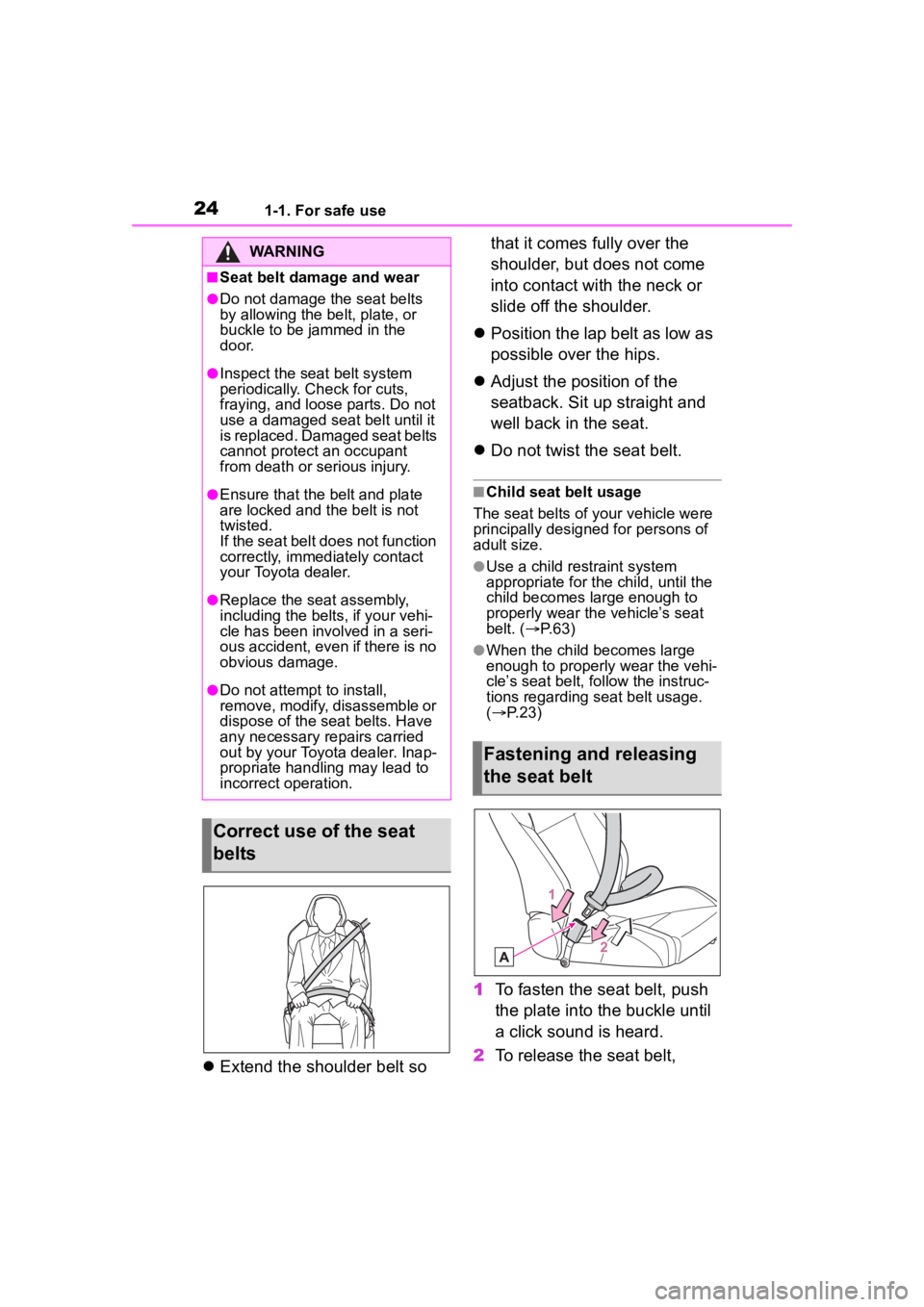
241-1. For safe use
Extend the shoulder belt so that it comes fully over the
shoulder, but does not come
into contact with the neck or
slide off the shoulder.
Position the lap belt as low as
possible over the hips.
Adjust the position of the
seatback. Sit up straight and
well back in the seat.
Do not twist the seat belt.
■Child seat belt usage
The seat belts of your vehicle were
principally designed for persons of
adult size.
●Use a child restraint system
appropriate for the child, until the
child becomes large enough to
properly wear the vehicle’s seat
belt. ( P. 6 3 )
●When the child becomes large
enough to properl y wear the vehi-
cle’s seat belt, follow the instruc-
tions regarding seat belt usage.
( P. 2 3 )
1 To fasten the seat belt, push
the plate into the buckle until
a click sound is heard.
2 To release the seat belt,
WARNING
■Seat belt damage and wear
●Do not damage the seat belts
by allowing the belt, plate, or
buckle to be jammed in the
door.
●Inspect the seat belt system
periodically. Check for cuts,
fraying, and loose parts. Do not
use a damaged sea t belt until it
is replaced. Damaged seat belts
cannot protect an occupant
from death or serious injury.
●Ensure that the belt and plate
are locked and the belt is not
twisted.
If the seat belt does not function
correctly, immediately contact
your Toyota dealer.
●Replace the seat assembly,
including the belts, if your vehi-
cle has been involved in a seri-
ous accident, even if there is no
obvious damage.
●Do not attempt to install,
remove, modify, disassemble or
dispose of the seat belts. Have
any necessary repairs carried
out by your Toyota dealer. Inap-
propriate handling may lead to
incorrect operation.
Correct use of the seat
belts
Fastening and releasing
the seat belt
Page 25 of 449
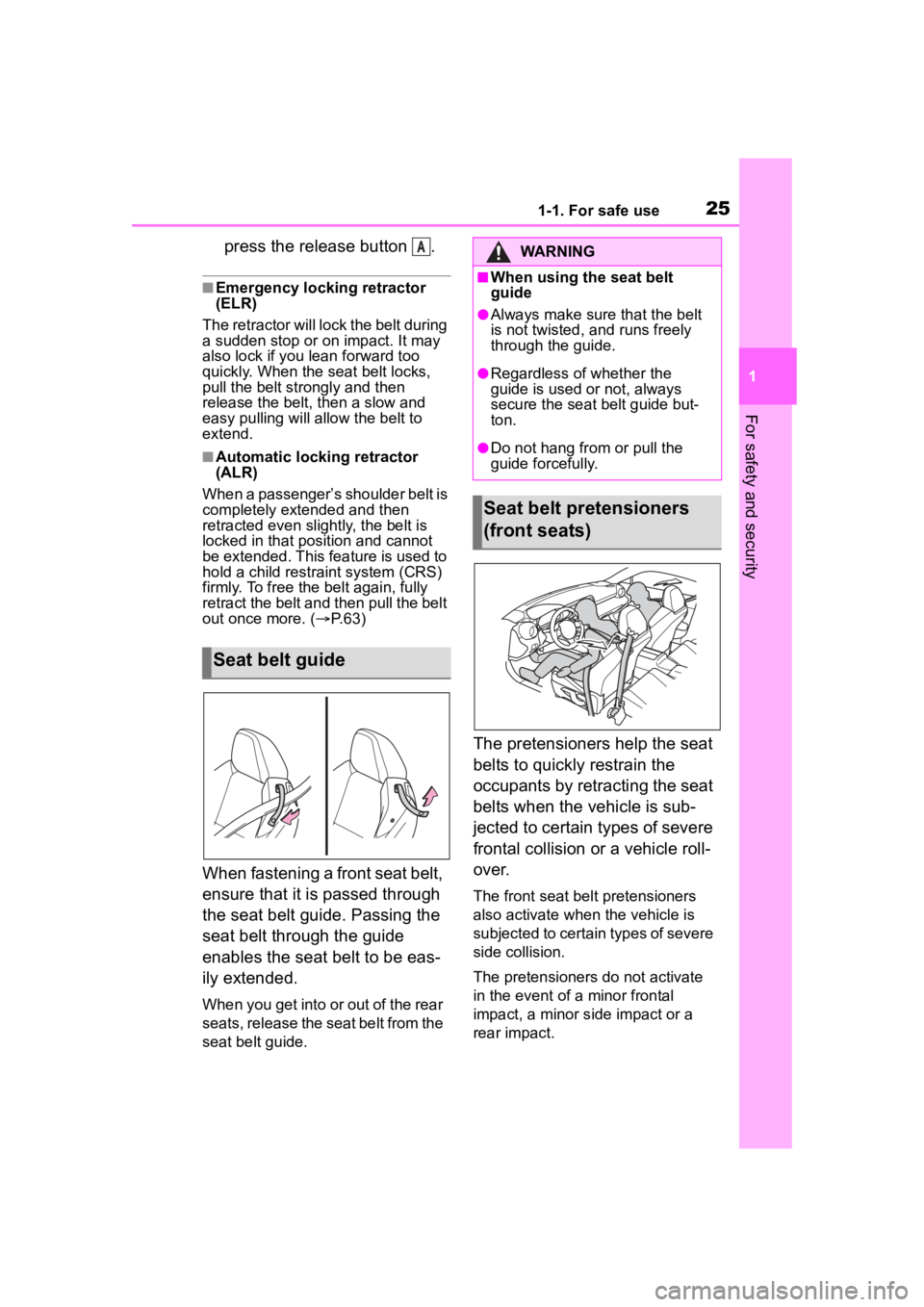
251-1. For safe use
1
For safety and security
press the release button .
■Emergency locking retractor
(ELR)
The retractor will lock the belt during
a sudden stop or on impact. It may
also lock if you lean forward too
quickly. When the seat belt locks,
pull the belt str ongly and then
release the belt, then a slow and
easy pulling will allow the belt to
extend.
■Automatic locking retractor
(ALR)
When a passenger’s shoulder belt is
completely extended and then
retracted even slightly, the belt is
locked in that position and cannot
be extended. This feature is used to
hold a child restraint system (CRS)
firmly. To free the belt again, fully
retract the belt and then pull the belt
out once more. ( P. 6 3 )
When fastening a front seat belt,
ensure that it is passed through
the seat belt guide. Passing the
seat belt through the guide
enables the seat belt to be eas-
ily extended.
When you get into or out of the rear
seats, release the seat belt from the
seat belt guide.
The pretensioners help the seat
belts to quickly restrain the
occupants by retracting the seat
belts when the vehicle is sub-
jected to certain types of severe
frontal collision or a vehicle roll-
over.
The front seat belt pretensioners
also activate when the vehicle is
subjected to certain types of severe
side collision.
The pretensioners do not activate
in the event of a minor frontal
impact, a minor s ide impact or a
rear impact.
Seat belt guide
AWARNING
■When using the seat belt
guide
●Always make sure that the belt
is not twisted, and runs freely
through the guide.
●Regardless of whether the
guide is used or not, always
secure the seat belt guide but-
ton.
●Do not hang fr om or pull the
guide forcefully.
Seat belt pretensioners
(front seats)
Page 26 of 449
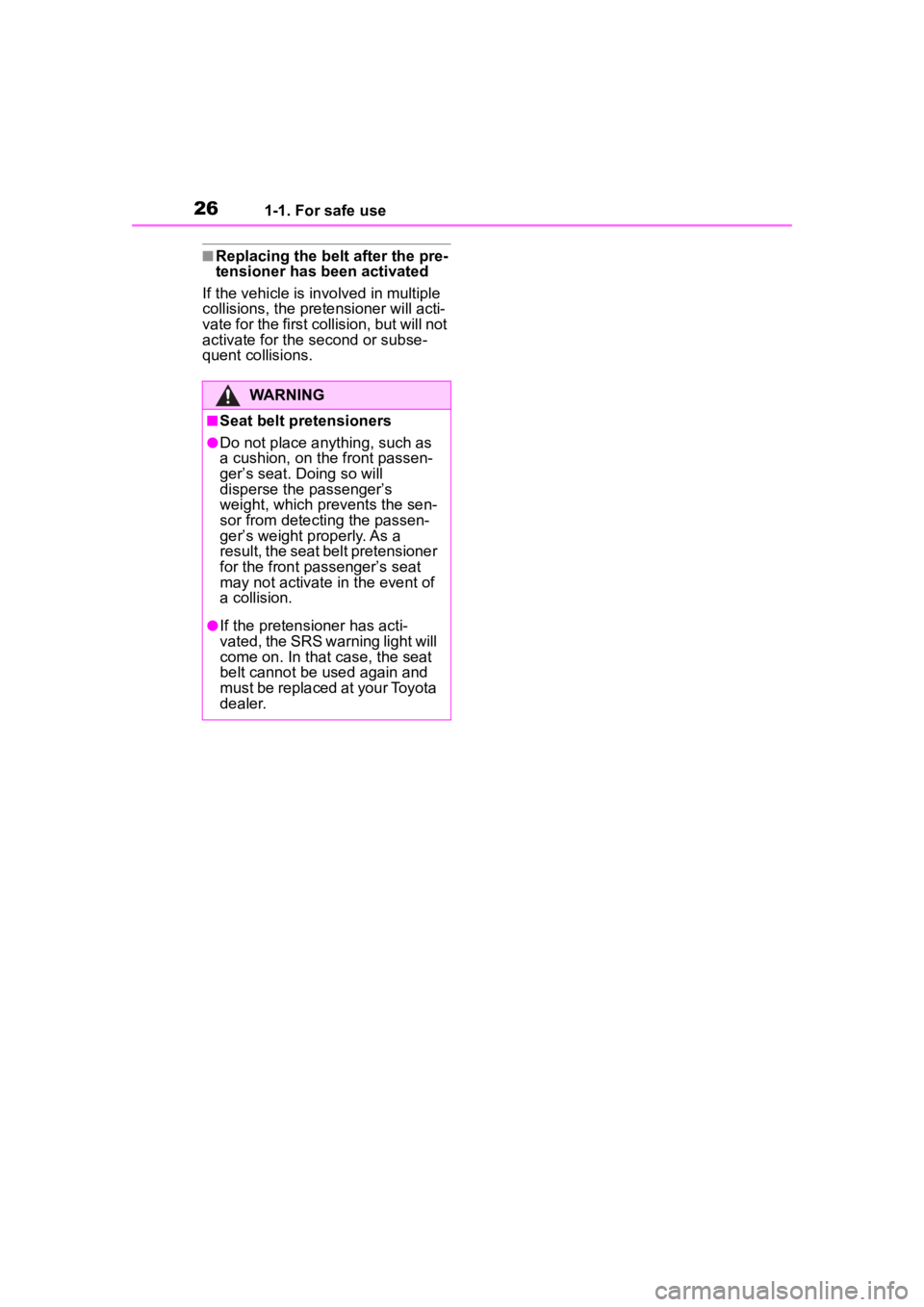
261-1. For safe use
■Replacing the belt after the pre-
tensioner has been activated
If the vehicle is in volved in multiple
collisions, the pretensioner will acti-
vate for the first collision, but will not
activate for the second or subse-
quent collisions.
WARNING
■Seat belt pretensioners
●Do not place anything, such as
a cushion, on the front passen-
ger’s seat. Doing so will
disperse the passenger’s
weight, which prevents the sen-
sor from detecting the passen-
ger’s weight properly. As a
result, the seat belt pretensioner
for the front passenger’s seat
may not activate in the event of
a collision.
●If the pretensioner has acti-
vated, the SRS warning light will
come on. In that case, the seat
belt cannot be used again and
must be replaced at your Toyota
dealer.
Page 27 of 449

271-1. For safe use
1
For safety and security
■Location of the SRS airbags
The SRS airbags are stowed in the following locations.
SRS airbags
Supplemental Restraint System (SRS) name is used because
the airbag system supplements the vehicle’s seatbelts.
This vehicle is equipped with a supplemental restraint system
which consists of seven airbags.
The configurations are as follows.
Driver’s and front passenger’s frontal airbags
Driver’s and front passenger’s side airbags
Curtain shield airbags (for driver, front passenger and rear pa s-
sengers)
Knee airbag for driver
These SRS airbags are designed only to be a supplement to
the primary protection provided by the seatbelt.
The system also controls front seatbelt pretensioners. For
operation instructions and precautions concerning the seat-
belt pretensioner, refer to P.25.
Components
Page 28 of 449
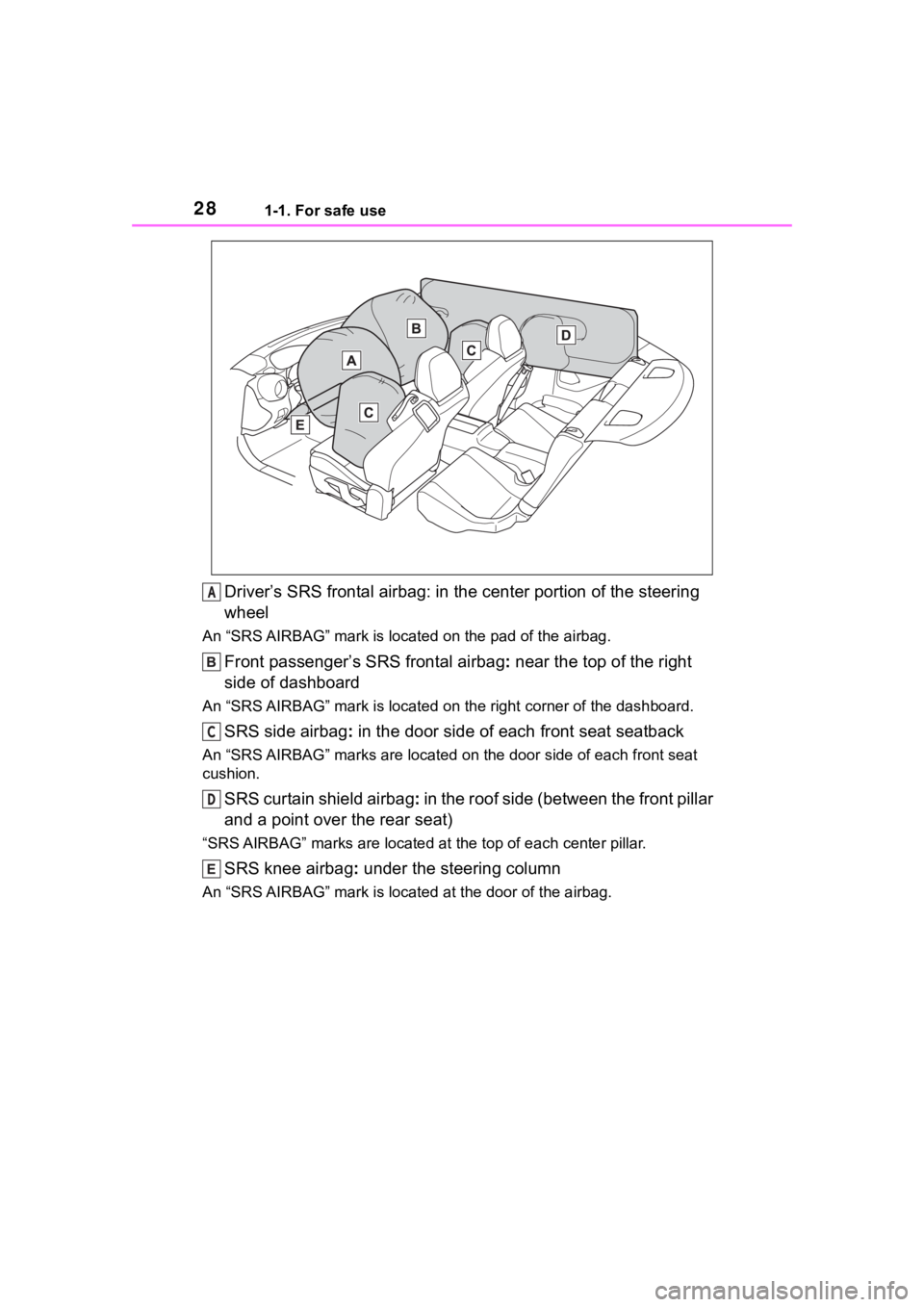
281-1. For safe use
Driver’s SRS frontal airbag: in the center portion of the steering
wheel
An “SRS AIRBAG” mark is loca ted on the pad of the airbag.
Front passenger’s SRS frontal airbag : near the top of the right
side of dashboard
An “SRS AIRBAG” mark is located on the right corner of the dash board.
SRS side airbag : in the door side of each front seat seatback
An “SRS AIRBAG” marks are locat ed on the door side of each front seat
cushion.
SRS curtain shield airbag : in the roof side (between the front pillar
and a point over the rear seat)
“SRS AIRBAG” marks are located a t the top of each center pillar.
SRS knee airbag: under the steering column
An “SRS AIRBAG” mark is locate d at the door of the airbag.
A
C
D
Page 29 of 449
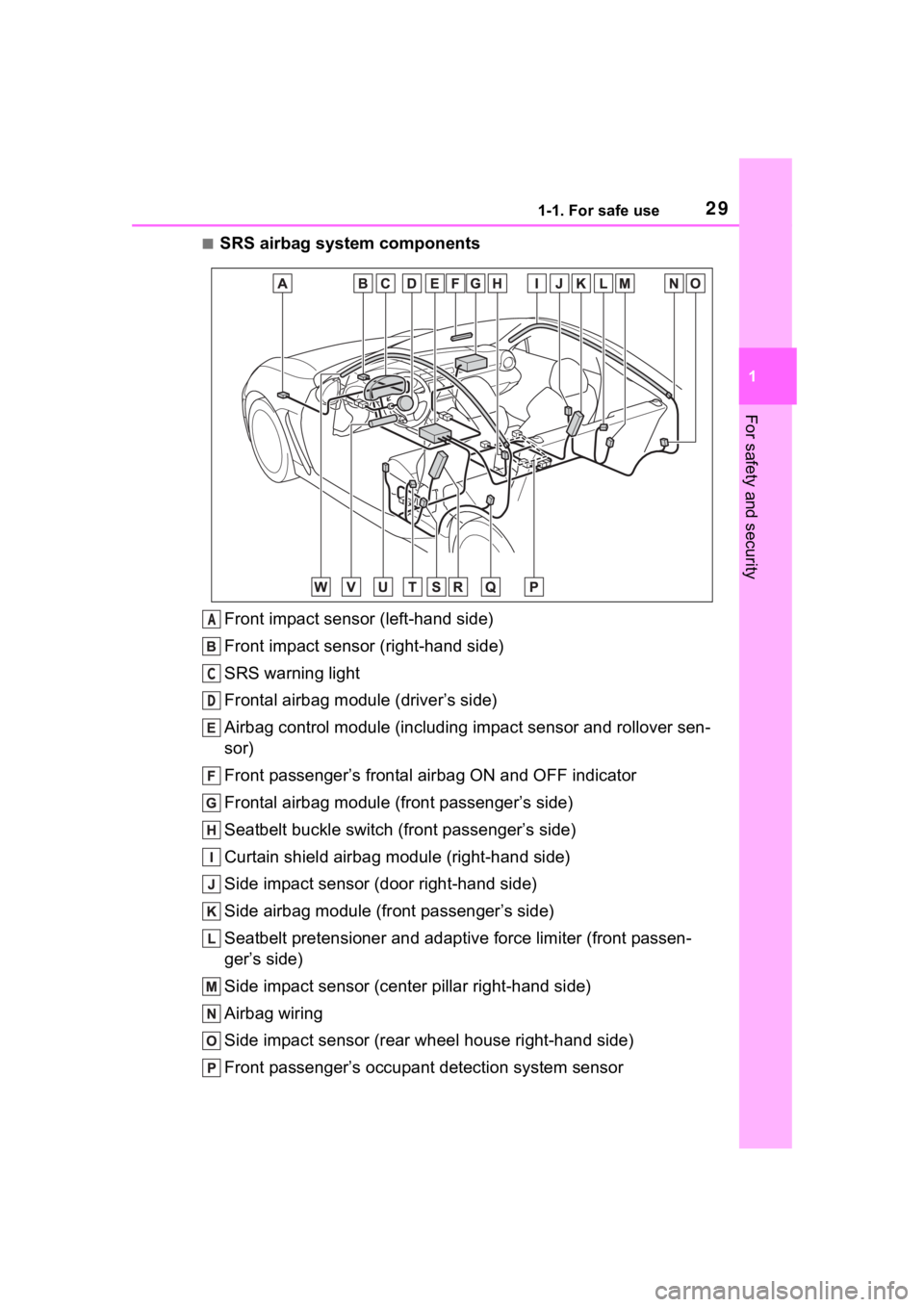
291-1. For safe use
1
For safety and security
■SRS airbag system componentsFront impact sensor (left-hand side)
Front impact sensor (right-hand side)
SRS warning light
Frontal airbag module (driver’s side)
Airbag control module (including impact sensor and rollover sen-
sor)
Front passenger’s frontal airbag ON and OFF indicator
Frontal airbag module (front passenger’s side)
Seatbelt buckle switch (front passenger’s side)
Curtain shield airbag module (right-hand side)
Side impact sensor (door right-hand side)
Side airbag module (fr ont passenger’s side)
Seatbelt pretensioner and adaptive force limiter (front passen-
ger’s side)
Side impact sensor (center pillar right-hand side)
Airbag wiring
Side impact sensor (rear wheel house right-hand side)
Front passenger’s occupant detection system sensor
A
C
D
Page 30 of 449
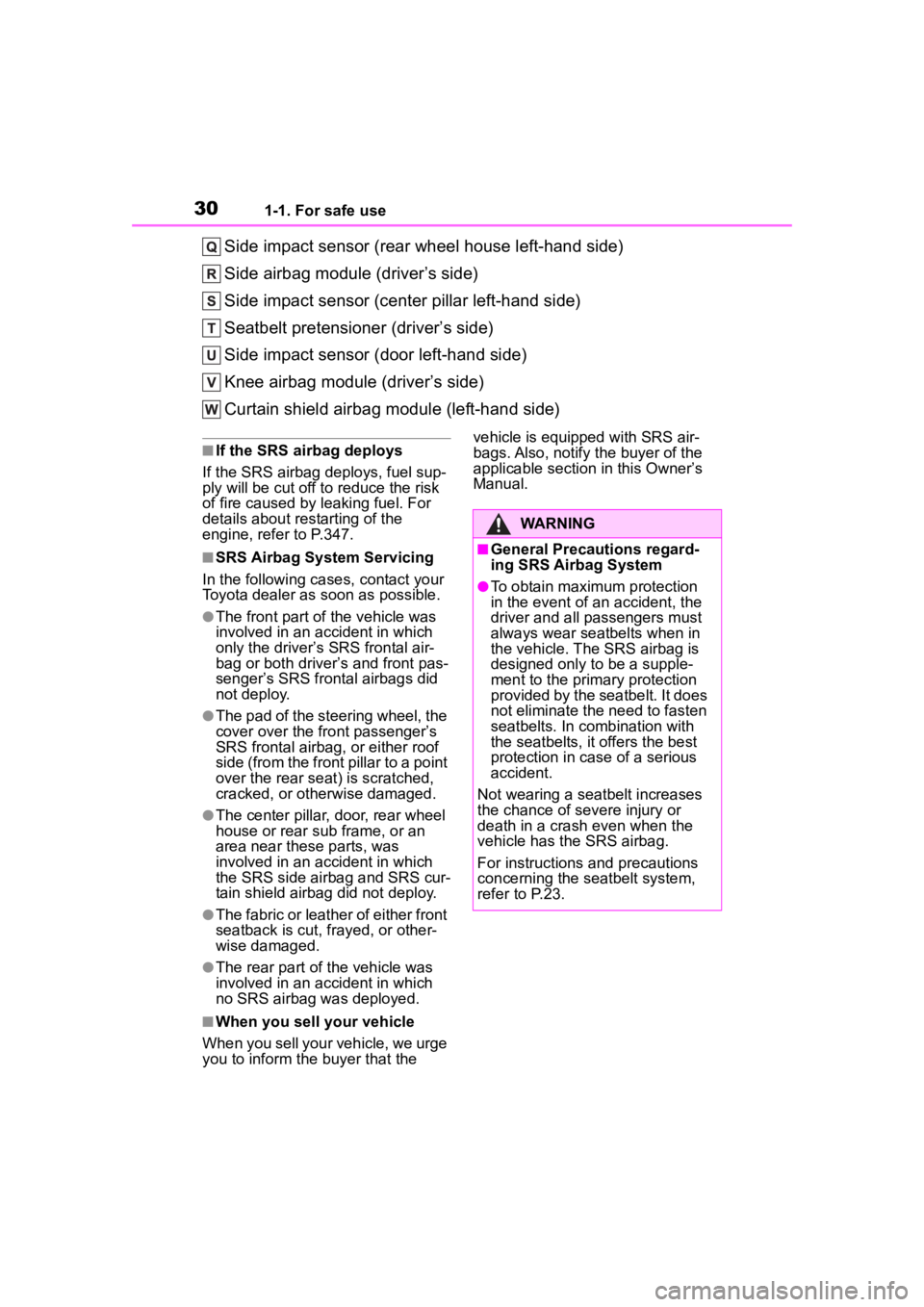
301-1. For safe use
Side impact sensor (rear wheel house left-hand side)
Side airbag module (driver’s side)
Side impact sensor (center pillar left-hand side)
Seatbelt pretensioner (driver’s side)
Side impact sensor (door left-hand side)
Knee airbag module (driver’s side)
Curtain shield airbag module (left-hand side)
■If the SRS airbag deploys
If the SRS airbag deploys, fuel sup-
ply will be cut off to reduce the risk
of fire caused by leaking fuel. For
details about restarting of the
engine, refer to P.347.
■SRS Airbag System Servicing
In the following cases, contact your
Toyota dealer as soon as possible.
●The front part of the vehicle was
involved in an accident in which
only the driver’s SRS frontal air-
bag or both driver’s and front pas-
senger’s SRS frontal airbags did
not deploy.
●The pad of the steering wheel, the
cover over the front passenger’s
SRS frontal airbag, or either roof
side (from the front pillar to a point
over the rear seat) is scratched,
cracked, or otherwise damaged.
●The center pillar, door, rear wheel
house or rear sub frame, or an
area near these parts, was
involved in an accident in which
the SRS side air bag and SRS cur-
tain shield airbag did not deploy.
●The fabric or leather of either front
seatback is cut, frayed, or other-
wise damaged.
●The rear part of the vehicle was
involved in an accident in which
no SRS airbag was deployed.
■When you sell your vehicle
When you sell your vehicle, we urge
you to inform the buyer that the vehicle is equipped with SRS air-
bags. Also, notify the buyer of the
applicable section in this Owner’s
Manual.
WARNING
■General Precautions regard-
ing SRS Airbag System
●To obtain maximum protection
in the event of an accident, the
driver and all passengers must
always wear seatbelts when in
the vehicle. The SRS airbag is
designed only to be a supple-
ment to the primary protection
provided by the seatbelt. It does
not eliminate the need to fasten
seatbelts. In combination with
the seatbelts, it offers the best
protection in case of a serious
accident.
Not wearing a seat belt increases
the chance of severe injury or
death in a crash even when the
vehicle has the SRS airbag.
For instructions and precautions
concerning the seatbelt system,
refer to P.23.